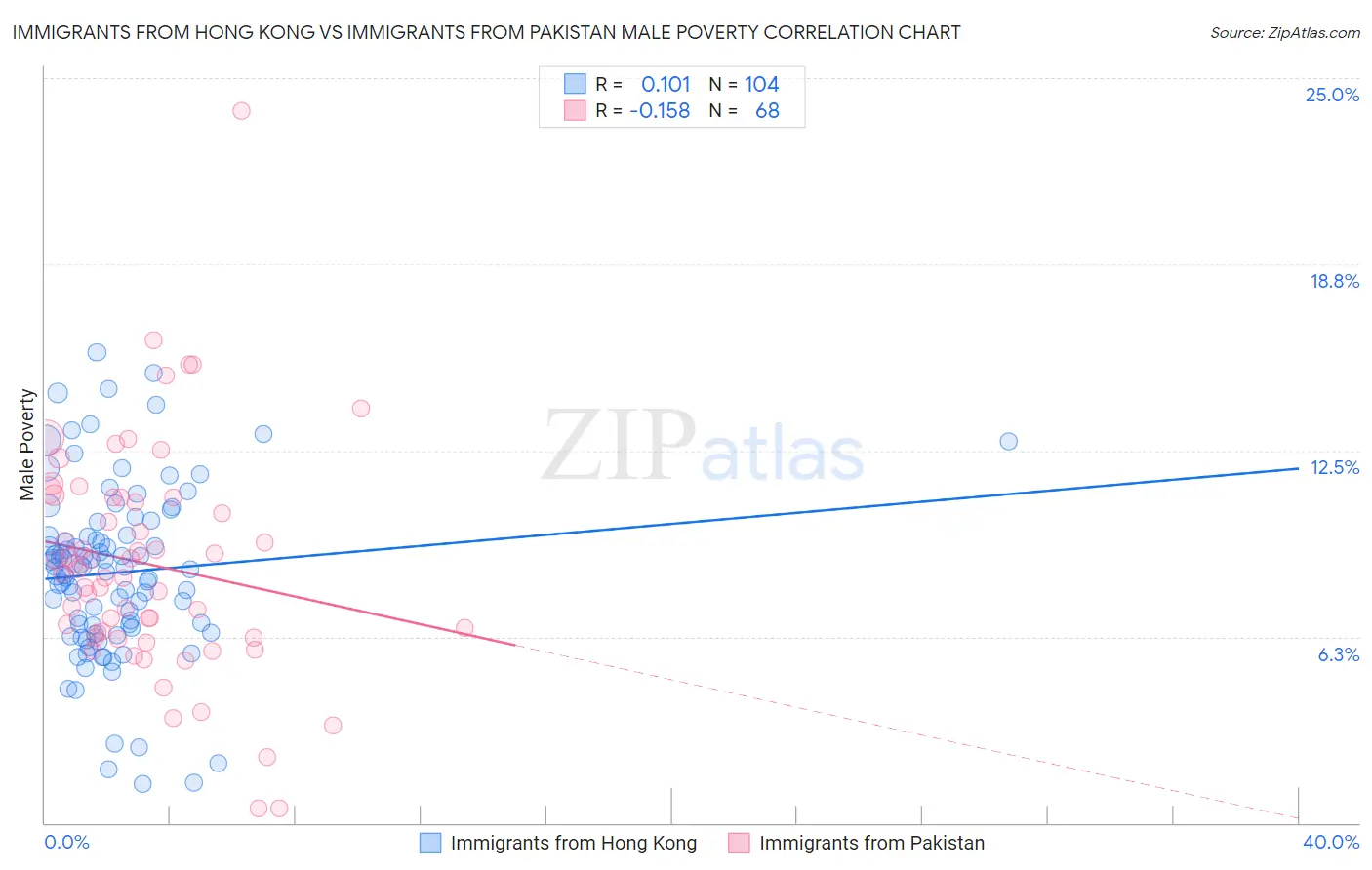Immigrants from Hong Kong vs Immigrants from Pakistan Male Poverty
COMPARE
Immigrants from Hong Kong
Immigrants from Pakistan
Male Poverty
Male Poverty Comparison
Immigrants from Hong Kong
Immigrants from Pakistan
9.6%
MALE POVERTY
99.7/ 100
METRIC RATING
19th/ 347
METRIC RANK
9.9%
MALE POVERTY
99.2/ 100
METRIC RATING
38th/ 347
METRIC RANK
Immigrants from Hong Kong vs Immigrants from Pakistan Male Poverty Correlation Chart
The statistical analysis conducted on geographies consisting of 253,850,467 people shows a poor positive correlation between the proportion of Immigrants from Hong Kong and poverty level among males in the United States with a correlation coefficient (R) of 0.101 and weighted average of 9.6%. Similarly, the statistical analysis conducted on geographies consisting of 283,757,026 people shows a poor negative correlation between the proportion of Immigrants from Pakistan and poverty level among males in the United States with a correlation coefficient (R) of -0.158 and weighted average of 9.9%, a difference of 3.1%.

Male Poverty Correlation Summary
| Measurement | Immigrants from Hong Kong | Immigrants from Pakistan |
| Minimum | 1.3% | 0.49% |
| Maximum | 15.8% | 23.9% |
| Range | 14.5% | 23.4% |
| Mean | 8.4% | 8.7% |
| Median | 8.6% | 8.5% |
| Interquartile 25% (IQ1) | 6.6% | 6.3% |
| Interquartile 75% (IQ3) | 9.6% | 10.9% |
| Interquartile Range (IQR) | 3.0% | 4.6% |
| Standard Deviation (Sample) | 2.9% | 3.8% |
| Standard Deviation (Population) | 2.9% | 3.8% |
Demographics Similar to Immigrants from Hong Kong and Immigrants from Pakistan by Male Poverty
In terms of male poverty, the demographic groups most similar to Immigrants from Hong Kong are Latvian (9.6%, a difference of 0.10%), Lithuanian (9.5%, a difference of 0.18%), Immigrants from Scotland (9.6%, a difference of 0.36%), Croatian (9.6%, a difference of 0.61%), and Italian (9.6%, a difference of 0.62%). Similarly, the demographic groups most similar to Immigrants from Pakistan are Immigrants from Greece (9.8%, a difference of 0.37%), Czech (9.8%, a difference of 0.59%), Iranian (9.8%, a difference of 0.68%), Immigrants from Poland (9.8%, a difference of 0.99%), and Immigrants from Northern Europe (9.7%, a difference of 1.1%).
| Demographics | Rating | Rank | Male Poverty |
| Lithuanians | 99.8 /100 | #18 | Exceptional 9.5% |
| Immigrants | Hong Kong | 99.7 /100 | #19 | Exceptional 9.6% |
| Latvians | 99.7 /100 | #20 | Exceptional 9.6% |
| Immigrants | Scotland | 99.7 /100 | #21 | Exceptional 9.6% |
| Croatians | 99.7 /100 | #22 | Exceptional 9.6% |
| Italians | 99.7 /100 | #23 | Exceptional 9.6% |
| Swedes | 99.7 /100 | #24 | Exceptional 9.6% |
| Eastern Europeans | 99.6 /100 | #25 | Exceptional 9.6% |
| Burmese | 99.6 /100 | #26 | Exceptional 9.7% |
| Danes | 99.6 /100 | #27 | Exceptional 9.7% |
| Immigrants | Korea | 99.6 /100 | #28 | Exceptional 9.7% |
| Greeks | 99.6 /100 | #29 | Exceptional 9.7% |
| Poles | 99.5 /100 | #30 | Exceptional 9.7% |
| Tongans | 99.5 /100 | #31 | Exceptional 9.7% |
| Macedonians | 99.5 /100 | #32 | Exceptional 9.7% |
| Immigrants | Northern Europe | 99.5 /100 | #33 | Exceptional 9.7% |
| Immigrants | Poland | 99.5 /100 | #34 | Exceptional 9.8% |
| Iranians | 99.4 /100 | #35 | Exceptional 9.8% |
| Czechs | 99.4 /100 | #36 | Exceptional 9.8% |
| Immigrants | Greece | 99.3 /100 | #37 | Exceptional 9.8% |
| Immigrants | Pakistan | 99.2 /100 | #38 | Exceptional 9.9% |